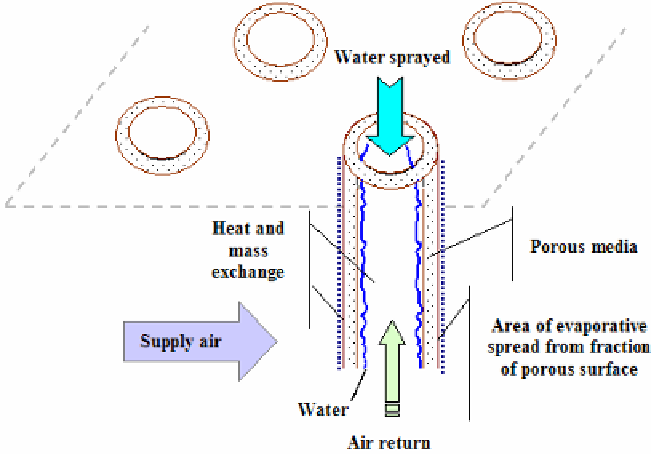Environmental Engineering Reference
In-Depth Information
As Johnson [2] et al. mentioned, most conventional direct evaporative cooling methods
involve collection and recirculation of water to keep the wetting media or misting region
saturated. There exists an environment of almost stagnant water in direct contact with the
outside air, which aids, if not properly maintained at significant costs, the spread of many
liquid phase-born bacterial diseases, most notably Legionnaire's disease.
Due to this fact, indirect evaporative cooling application has been commonly used,
despite the fact that indirect systems have lower efficiency in comparison with direct systems
[3]. An evolution from indirect evaporative cooling systems is the semi-indirect evaporative
cooling system with porous media. The cooling effect of the impulsed air would thus be the
addition of two processes: the heat exchange between the two air flows (supply and return)
plus the heat exchange process, via evaporation, between the air supply and the external wall.
Depending on the permeability of the wall of the solid porous cooler which separates the two
air flows, there is greater or lesser liquid diffusion (water) with evaporation towards the air
flow supply from the external pores, in all cases. The absolute humidity of the air supply is
the controlling factor in this mass transport process, which is why it has been called semi-
indirect. The semi-indirect evaporative cooler works with the following mechanisms:
•
Heat and mass transfer in the return air flow.
•
Spread of mass due to porosity and heat transport through the solid wall.
•
Evaporation or condensation as well as heat and mass exchange in the air flow
supply.
Figure 3. Evaporative Cooler: heat and mass transfer mechanisms.
All of these features are presented together, thus combining heat and mass transfer,
increasing the cooling effect of the air to be conditioned and achieving optimisation of the
thermal process [4] (See Figure 3).


